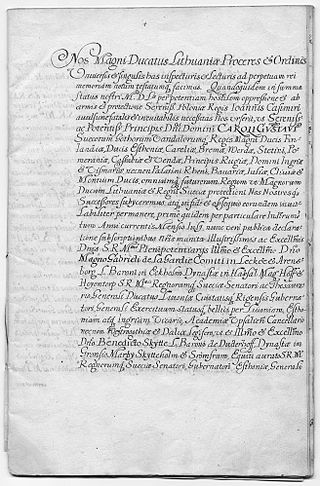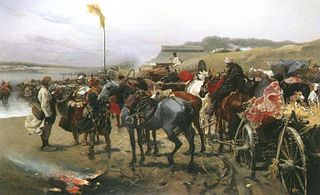This article needs additional citations for verification .(November 2024) |


Jan Kazimierz Sapieha the Elder (Lithuanian : Jonas Kazimieras Sapiega vyresnysis; died 1730) was a grand hetman of Lithuania from 1708 to 1709.
This article needs additional citations for verification .(November 2024) |


Jan Kazimierz Sapieha the Elder (Lithuanian : Jonas Kazimieras Sapiega vyresnysis; died 1730) was a grand hetman of Lithuania from 1708 to 1709.
He was the son of Franciszek Stefan Sapieha, father of Piotr Paweł Sapieha and Paweł Sapieha. A supporter of Stanisław Leszczyński, he took part in many battles of the Great Northern War. Charles XII of Sweden considered him a good commander, and influenced his relative, Jan Kazimierz Sapieha the Younger, to pass the grand hetman post to him. He defeated Grzegorz Antoni Ogiński at the battle of Lachowce, but in 1709, after the Russian victory of Swedes at Battle of Poltava, he surrendered to Augustus II the Strong and was forced to abandon his hetmanship. [1] In 1716, he joined the anti-Saxon Tarnogród Confederation. In the last years of his life he became a supporter of the Russian Empire, in particular, of Catherine I of Russia, for which in 1726 he was rewarded with a rank of field marshal, and in 1727, governor-general of Saint Petersburg (Saint Petersburg Governorate) and Ingria.
Stanisław Poniatowski was a Polish military commander, diplomat, and noble. Throughout his career, Poniatowski served in various military offices, and was a general in both the Swedish and Polish–Lithuanian militaries. He also held numerous civil positions, including those of podstoli of Lithuania and Grand Treasurer of the Lithuanian army in 1722, voivode of the Masovian Voivodeship in 1731, regimentarz of the Crown Army in 1728, and castellan of Kraków in 1752. Throughout his lifetime, he served in many starost positions.

Prince Michał Serwacy Wiśniowiecki was a Polish-Lithuanian nobleman, magnate, politician, diplomat, general, a successful military commander and the last male representative of the Wiśniowiecki family.
Jan Sapieha may refer to:

The Union of Kėdainiai or Agreement of Kėdainiai was an agreement between magnates of the Grand Duchy of Lithuania and the king of the Swedish Empire, Charles X Gustav, that was signed on 20 October 1655, during the Swedish Deluge of the Second Northern War. In contrast to the Treaty of Kėdainiai of 17 August, which put Lithuania under Swedish protection, the Swedish–Lithuanian union's purpose was to end the Lithuanian union with Poland and to set up the Grand Duchy of Lithuania as a protectorate under the Swedish Crown with some of the estates being ruled by the Radziwiłł (Radvila) family.

The House of Sapieha is a Polish-Lithuanian noble and magnate family of Ruthenian origin, descending from the medieval boyars of Smolensk and Polotsk. The family acquired great influence and wealth in the Polish–Lithuanian Commonwealth during the 16th century.

Jan Piotr Sapieha was a Polish-Lithuanian nobleman, general, politician, diplomat, governor of Uświat county, member of the Parliament and a skilled commander of the Polish troops stationing in the Moscow Kremlin.

Wincenty Aleksander Korwin Gosiewskide armis Ślepowron – was a Polish nobleman, general, Lithuanian Field Hetman from 1654, Grand Treasurer of Lithuania and Lithuanian Great-Quartermaster since 1652, General of Artillery of Lithuania from 1651, Grand-Master of the Pantry of Lithuania from 1646.

Kazimierz Jan Paweł Sapieha was a Grand Hetman of Lithuania commencing in 1682. He held the title of a Duke starting in 1700. In 1681, he became Field Hetman of Lithuania, the following year he also became the voivode of Vilnius.

Paul John Sapieha (1609–1665) was a Polish–Lithuanian nobleman (szlachcic).

Michał Kazimierz Pac was a nobleman and prominent military leader of the Polish-Lithuanian Commonwealth, and of one the most influential members of the magnate Pac family. Educated by Jesuits and Mikołaj Krzysztof "the Orphan" Radziwiłł, Pac joined the military at a young age and rose through its ranks to fight against Russian, Turkish, and Swedish armies. Throughout his life, Pac was the Field Hetman of Lithuania, Voivode of Smolensk, as well as Great Hetman. Known for being a devout and ambitious personality of the Baroque period, Pac was interred below the Church of St. Peter and St. Paul, Vilnius along with a memorial plaque he commissioned.

The House of Pac or Pacowie was one of the most influential noble families in the Polish–Lithuanian Commonwealth. Numerous high-ranking officials of the Commonwealth came from their ranks. Their coat of arms was Gozdawa.

Konstanty Kazimierz Brzostowski (1644–1722) was a Polish noble, count of the Holy See, and papal prelate. He was Grand Secretary of Lithuania from 1671, and shortly thereafter was Grand Writer of Lithuania. He was bishop of Smoleńsk from 1685 to 1687 and bishop of Vilnius from 1687.

Aleksander Michał Paweł Sapieha of Lis coat of arms was a noble of the Polish–Lithuanian Commonwealth.
The Lithuanian Civil War of 1697–1702 refers to the conflict between the powerful Sapieha family, which dominated the internal affairs of the Grand Duchy of Lithuania, and the anti-Sapieha coalition, so-called Republicans or Confederates. The latter were composed of opposing noble families that disliked Sapieha family's hegemony in the country. The szlachta was mostly on the side of the Republicans as they were angry at Sapieha's abuse and the taxes imposed on them to finance the Grand Ducal Lithuanian Army, which was mostly loyal to the Sapiehas.

The Constitution of 3 May 1791 is an 1891 Romantic oil painting on canvas by the Polish artist Jan Matejko. It is a large piece, and one of Matejko's best known. It memorializes the Polish Constitution of 3 May 1791, a milestone in the history of the Polish–Lithuanian Commonwealth and a high point of the Polish Enlightenment.

Michał Franciszek Sapieha was a Polish-Lithuanian magnate of the Sapieha family, Koniuszy of Lithuania, and a general of Lithuanian and Russian armies.

Grzegorz Antoni Ogiński was the Elder of Samogitia (1698–1709), Field Hetman of Lithuania (1703–1709) and Grand Hetman of Lithuania in 1709. He was the fourth and youngest son of Jan Jacek Ogiński, a Field Hetman of Lithuania.

The Battle of Valkininkai took place on November 18, 1700, during the Lithuanian Civil War, between forces of the Sapieha family, led by Michał Franciszek Sapieha, and an anti-Sapieha coalition of Wiśniowiecki, Ogiński, Radziwiłł and Pac families and their supporters, led by Michał Serwacy Wiśniowiecki.

Aleksander Paweł Sapieha, was a Polish-Lithuanian Prince of the Sapieha family, Marshal of the Court of Lithuania (1692) and Grand Marshal of Lithuania (1699).